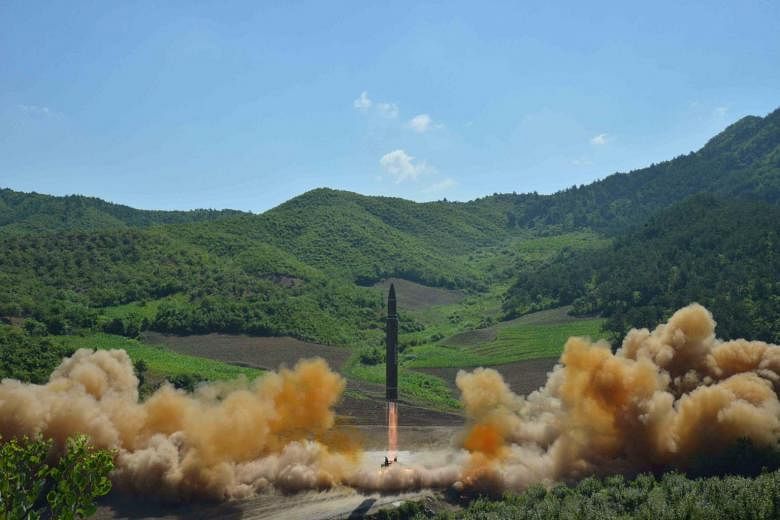SEOUL (BLOOMBERG) - It may already be too late for sanctions to halt North Korea's missile programme.
That is the view of analysts who have watched Mr Kim Jong Un accelerate progress on North Korea's decades-long quest for a functioning intercontinental ballistic missile (ICBM).
Last Friday's (July 28) launch, the second in a matter of weeks, showed that it is just a matter of time before the North Korean leader has a full-fledged ICBM that could hit any part of the United States with a nuclear weapon.
As North Korea's economy holds up, and the regime moves beyond the startup costs of its nuclear programme, efforts to choke off its finances become less effective, the analysts say.
That leaves US President Donald Trump with limited options.
A military strike could have devastating consequences for the Korean peninsula. At the same time the US is loathe to make the concessions that Mr Kim demands to get him to the negotiating table.
"No amount of sanctions will stop Kim Jong Un from having his ICBM," said Dr Andrei Lankov, a professor of Korean studies at Kookmin University in Seoul, who has written several books on North Korea.
"As long as the Kim family stays in power - and they're likely to stay in power for a long time - denuclearisation is not possible. Period."
The US has said it would not call another meeting of the United Nations Security Council after the latest missile test, with Ambassador Nikki Haley saying another resolution would be pointless.
The US and Japan both blame China and Russia - veto-wielding members of the Security Council that oppose more sanctions - for propping up Mr Kim's regime.
Mr Trump, who blasted China on Twitter for doing "NOTHING" on North Korea, is considering trade restrictions and sanctions against the world's second-biggest economy, Politico reported on Monday.
In June, his administration sanctioned a regional Chinese bank, a shipping company and two Chinese citizens over dealings with North Korea.
The US President is keeping "all options on the table" when it comes to North Korea, White House spokesman Sarah Sanders said on Tuesday at a briefing.
Still, Secretary of State Rex Tillerson urged continued "peaceful pressure" on Pyongyang, telling reporters the US goal is not to topple Mr Kim's regime or find "an excuse to send our military north".
China fears a collapse of Mr Kim's regime could lead to a refugee crisis and US troops on its border. Even though relations between the neighbours have been frosty of late, China still accounts for about 90 per cent of North Korea's total trade.
North Korea's economy seems to be doing well despite the sanctions. Growth stood at 3.9 per cent in 2016, the fastest rate in 17 years, according to South Korea's central bank.
Data from China's customs bureau show trade remained active this year, with North Korea logging a trade deficit of US$800 million (S$1.08 billion) in the first six months - suggesting it has cash to buy goods.
While no reliable estimates exist on how much it costs Mr Kim to test his weapons, analysts say the biggest investments - building facilities - have already been made.
"It's ridiculous if you believe the North needs billions of dollars to develop its nuclear weapons and missiles," said Mr Lim Eul Chul, director for strategic planning at the Centre for International Cooperation for North Korean Development at Kyungnam University in South Korea.
"He doesn't pay his scientists that much and North Korea can make most of the weapons components internally on its own."
US Marine General Joseph Dunford, chairman of the Joint Chiefs of Staff, said last month that North Korea is on an "irreversible path" to obtaining a fully-functional ICBM. Weapons analysts debate how much more work is needed.
North Korea started developing its nuclear technology in the 1960s, mostly with help from the Soviet Union and then Russia. The Kim dynasty managed to avoid large outlays by making incremental advances over decades.
The missile launched last Friday flew as high as 3,700km before it fell into the sea near Japan 1,000km away. If it was launched at a normal trajectory, analysts say it could have travelled about 10 times further - enough to hit Denver or Chicago, depending on the flight path.
Questions remain over whether North Korea has mastered the ability to put a nuclear warhead on a missile that can survive re-entry into the Earth's atmosphere. It also needs to be able to put multiple warheads on a missile to evade defence systems, and ensure it accurately hits a specific target.
The test missiles have used liquid fuel, which can take hours to fill, making them susceptible to attack. North Korea's goal is to have a solid-fuel rocket that would allow a mobile ICBM to be launched without much preparation.
North Korea's capabilities are currently on a par with the US and Soviet Union in the 1960s and 1970s, according to Mr Jeffrey Lewis, director of the East Asia Nonproliferation Program at Middlebury Institute of International Studies at Monterey.
"There is a technology diffusion that has gone on so far that export controls and sanctions have a very, very small impact," he said in Tokyo this week.
At this stage, it may be possible to limit North Korea's weapons advancement through a combination of pressure, incentives and security guarantees, according to Mr Michael Kovrig, a senior adviser on Northeast Asia for the International Crisis Group.
"Tighter sanctions could slow but not stop Pyongyang's progress," Mr Kovrig said. "North Korea's regime likely sees a nuclear deterrent as essential for its survival, and probably would be willing and able to suffer through extreme hardship without budging."

